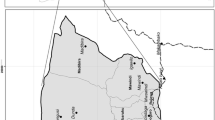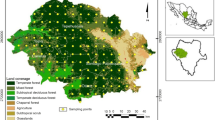Abstract
This article presents a methodology for the valuation of agroforestry with respect to fuelwood supply for cooking and its opportunity cost. The share of fuelwood consumption declined gradually from 78 to 67% and 30 to 14% for cooking in rural and urban India, during 1993–94 to 2011–12, respectively. However, the total consumption of fuelwood increased significantly from 106 to 130 million tonnes (Mt) in the corresponding period due to population growth. Fuelwood and chips are in the process of substitution with Liquefied Petroleum Gas (LPG) gradually and many LPG-adopter households continued to use fuelwood as well. The results verified that the maximum quantity of fuelwood for cooking was obtained from agroforestry systems (64%), followed by forests (24%), and from common property resources (12%) during 2011–12. The annual total calorific energy generated from agroforestry through fuelwood, was estimated at 1297.4 PJ, valued at US$ 4053 million. Around 103 Mt of dry dung cake needs to be burnt to generate the same amount of energy. It is estimated that by replacing dung cake by fuelwood derived from agroforestry systems, could save US$ 1116.6 million annually, sparing the dung cake for use as farmyard manure. In another scenario, if entire energy derived from fuelwood obtained from the agroforestry system is to be replaced by LPG, it would require over 196.4 million additional domestic LPG connections that would incur an expenditure of about US$ 36,487.5 million at the country level for the year 2011–12.


Similar content being viewed by others
References
Arnold JEM, Kohlin M, Persson G, Shepherd, RG (2003) Fuelwood Revisited: What has changed in the last decade? Centre of International Forestry Research (CIFOR), Occasional Paper No. 39, Bogor, Indonesia
Bhattacharya SC, Salam Abdul P (2002) Low greenhouse gas biomass option for cooking in the developing countries. Biomass Bioenergy 22:305–317
CAG (2019) Report of the Comptroller and Auditor General of India on Pradhan Mantri Ujjwala Yojana. Union Government (Commercial). Ministry of Petroleum and Natural Gas No. 14 of 2019 (Performance Audit), Comptroller and Auditor General of India
Census of India (2011) Office of the Registrar General & Census Commissioner, India. Ministry of Home Affairs, Government of India
CSO (2014) Report of the sub-committee on agriculture and allied sectors, estimation procedures for the valuation of agricultural products, Central Statistics Office, Ministry of Statistics and Programme Implementation, Government of India, New Delhi
CSO (2015) Changes in methodology and data sources in the new series of national accounts, base year 2011-12, Central Statistics Office, Ministry of Statistics and Programme Implementation, Government of India, New Delhi
Dikshit AK, Brithal P (2010) Environmental value of dung in mixed crop-livestock systems. Indian J Anim Sci 80(7):579–682
Eurostat (2019) Wood as a source of energy: Statistics Explained. Accessed from https://ec.europa.eu/eurostat/statistics-explained/index.php?title=Wood_as_a_source_of_energy
FAO (1997) Regional Study on Wood Energy today and Tomorrow in Asia, Field document No. 50, Food and Agriculture Organization of the United Nations, Bangkok
FAO (2010a) What woodfuels can do to mitigate climate change? FAO Forestry Paper No.162, Food and Agriculture Organization of the United Nations, Rome
FAO (2010b) Woodfuels and climate change mitigation: Case studies from Brazil, India and Mexico. Forests and Climate Change Working Paper No. 6, Food and Agriculture Organization of the United Nations, Rome
FAO (2012) Yearbook of Forest Products. Food and Agriculture Organization of the United Nations, Rome
FAO (2014) State of the World’s Forests 2014: Enhancing the socioeconomic benefits from forests. Food and Agriculture Organization of the United Nations, Rome
FAO (2015) Wood Fuels Handbook. Food and Agriculture Organization of the United Nations, Pristina
FAO (2016a) Forestry for a low-carbon future: integrating forests and wood products in climate change strategies. Forestry Paper No. 177, Food and Agriculture Organization of the United Nations, Rome
FAO (2016b) State of the World’s Forests 2016, Forests and agriculture: Land use challenges and opportunities. Food and Agriculture Organization of the United Nations, Rome
FAO (2016c) Yearbook of Forest Products. Food and Agriculture Organization of the United Nations, Rome
FAO (2018) The State of the World’s Forests: Forests Pathways to Sustainable Development. Food and Agriculture Organization of the United Nations, Rome
FSI (2009) India State of the Forest Report, 2009. Ministry of Environment, Forest and Climate Change, Government of India, Dehradun, India
FSI (2011) India State of the Forest Report, 2011. Ministry of Environment, Forest and Climate Change, Government of India, Dehradun, India
GIZ (2015) Towards sustainable modern wood energy development: Stocktaking paper on successful initiatives in developing countries in the field of wood energy development. Federal Ministry of Economic Cooperation and Development, Bonn, Germany
GoI (2016a) Agricultural Statistics at a Glance-2015, Directorate of Economics and Statistics. Ministry of Agriculture and Farmers Welfare, Government of India, New Delhi
GoI (2016b) Annual Report, 2015-16. Ministry of Chemicals and fertilizers, New Delhi
GoI (2016c) Annual Report, 2015-16. Ministry of New and Renewable Energy, New Delhi
GoI (2016d) Annual Report, 2015-16. Ministry of Petroleum and Natural Gas, New Delhi
GoI (2016e) Assessment report: Primary survey on household cooking fuel usage and willingness to convert to LPG. Petroleum Planning & Analysis Cell, Ministry of Petroleum and Natural Gas, Government of India
Gould CF, Urpelainen J (2018) LPG as a clean cooking fuel: Adoption, use, and impact in rural India. Energy Policy 122:395–408
Gregersen H, Draper S, Elz D (1989) People and trees, Economic Development Institute of World Bank
ICAR (2009) Hand Book of Agriculture, Indian Council of Agricultural Research, Department of Agricultural Research and Education, Ministry of Agriculture and Farmers Welfare, Government of India, New Delhi
IEA (2015) India Energy Outlook. World energy outlook special report, International Energy Agency, Paris, France
IEA (2017) Energy Access Outlook 2017: From poverty to prosperity. International Energy Agency, Paris, France
IEA (2018) Energy efficiency 2018: Analysis and outlooks to 2040. International Energy Agency, Paris, France
IFPRI (1992) Priorities for forestry and agroforestry policy research: Report of an international workshop / edited by Hans Gregersen, Peter Oram, John Spears. International Food Policy Research Institute, Washington DC
IPCC (2012) Renewable energy sources and climate change mitigation: special report of the Intergovernmental Panel on Climate Change. Cambridge University Press, Cambridge
Joon V, Chandra A, Bhattacharya M (2009) Household energy consumption pattern and socio-cultural dimensions associated with it: A case study of rural Haryana, India. Biomass Bioenergy 33:1509–1512
Kursten E (2000) Fuelwood production in agroforestry systems for sustainable land use and CO2-mitigation. Ecol Eng 16:S69–S72
Leach G, Gowen M (1987) Household Energy Handbook: An Interim Guide and Reference Manual, World Bank. Technical Paper No. 67, Washington, D.C
Leach G (1992) The energy transition. Energy Policy 20(2):116–123
Matthews R, Robertson K (2005) Answers to ten frequently asked questions about bioenergy, carbon sinks and their role in global climate change. IEA Bioenergy, Task 38
Mishra A (2008) Determinants of fuelwood use in rural Orissa: Implications for energy transition, South Asian Network for Development and Environmental Economics (SANDEE), working paper No. 37–08, Kathmandu, Nepal
MS Swaminathan Research Foundation (2010) Status Report on Use of Fuelwood in India. Working Paper, PISCES Research Consortium. London: Department for International Development, 11pp
Morelli BS, Cashman M Rodgers (2017) Life Cycle Assessment of Cooking Fuel Systems in India, China, Kenya, and Ghana. U.S. Environmental Protection Agency, Washington, DC, USA
Natarajan I (1996) Trends in firewood consumption in rural India, National Council of Applied Economic Research (NCAER). Margin 28:41–47
NCAER (1985) Domestic fuel survey with special reference to Kerosene, Vols 1 and 2, National Council of Applied Economic Research, New Delhi
Ndayambaje JD, Mohren GMJ (2011) Fuelwood demand and supply in Rawanda and the role of Agroforestry. Agrofor Syst 83:303–320
NITI Aayog (2014) Report of the expert group to review the methodology for measurement of poverty, National Institution for Transforming India, erstwhile Planning Commission, Government of India, New Delhi
Niti Aayog (2017) Draft National Energy Policy. National Institution for Transforming India, Government of India, New Delhi
NSSO (1997) Energy used by Indian households, 50th round (1993-94), National Sample Survey Office, Ministry of Statistics and Programme Implementation, Government of India, New Delhi
NSSO (1999) Common Property Resources in India, Report No. 452, National Sample Survey Office, Ministry of Statistics and Programme Implementation, Government of India, New Delhi
NSSO (2007) Energy sources of Indian households for cooking and lighting, 61st round, (2004-05), National Sample Survey Office, Ministry of Statistics and Programme Implementation, Government of India, New Delhi
NSSO (2012) Energy sources of Indian households for cooking and lighting, 66th round, report No. 542, (2009–10), National Sample Survey Office, Ministry of Statistics and Programme Implementation, Government of India, New Delhi
NSSO (2013) Household Consumption of Various Goods and Services in India, 68th round, report No. 558, (2011–12) National Sample Survey Office, Ministry of Statistics and Programme Implementation, Government of India, New Delhi
NSSO (2013) Key indicators of household consumer expenditure in India, 68th round, report No. 562, (2011–12), National Sample Survey Office, Ministry of Statistics and Programme Implementation, Government of India, New Delhi
NSSO (2015) Energy sources of Indian households for cooking and lighting, 68th round, report No. 567, (2011–12), National Sample Survey Office, Ministry of Statistics and Programme Implementation, New Delhi, Government of India
Pandey D (2002) Fuelwood Studies in India: Myth and reality. Centre of International Forestry Research (CIFOR) Jakarta, Indonesia
Panwar NL, Kurchania AK, Rathore NS (2009) Mitigation of greenhouse gases by adoption of improved biomass cookstoves. Mitig Adapt Strateg Glob Change 14:569–578
Parikh K S (2012) India’s emerging energy needs and supply options. Integrated Research and Action for Development (IRADe), New Delhi
PPAC (2019) Ready Reckoner. Petroleum Planning and Analysis Cell. Ministry of Petroleum and Natural Gas, Government of India, New Delhi
RBI, Handbook of Indian Economy-2015-16 (2016), Reserve Bank of India, Ministry of Finance, Government of India, New Delhi
Saxena NC (1993) Forestry policies and woodfuels in India-Problems and prospects. Wood Energy Development: Planning, Policies and Strategies. RWEDP/FAO. Bangkok, RWEDP/FAO 3:55-84
Sehgal M, Rizwan SA, Krishnan A (2014) Disease burden due to biomass cooking-fuel-related household air pollution among women in India. Global Health Action 7:1
Sharma PK, Kapoor KK (2005) Problems and prospective of nitrogen fixation in agroforestry systems. Proc Indian Natl Sci Acad B 71(3 & 4):145–161
Sharma JV (2017) Forestry Sector in India is Net Source of Green House Gases (GHGS). J Environ Sci Eng Technol 5:2–7
Singh M (2013) Is employment generation scheme hampering agricultural development? Agril Sit India 60(6):25–36
Singh P, Gundimeda H (2014) Life cycle energy analysis (LCEA) of cooking fuel sources used in India households. Energy Environ Eng 2(1):20–30
Sood KK, Mitchell CP (2011) Household level domestic fuel consumption and forest resource in relation to agroforestry adoption: Evidence against need-based approach. Biomass Bioenergy 35:337–345
Venkataraman V, Sagar AD, Habib G, Lam N, Smith KR (2010) The Indian National initiative for advanced biomass cookstoves: the benefits of clean combustion. Energy Sustain Dev 14:63–72
WHO (2016) Burning opportunity: clean household energy for health, sustainable development and wellbeing of women and children. Geneva, Switzerland
WHO (2018) Opportunities for transition to clean household energy: application of the household energy assessment rapid tool (HEART): India. Geneva, Switzerland
Acknowledgement
The authors are thankful to the ICAR-Central Agroforestry Research Institute for providing facilities to carry out this study. The authors also thankfully acknowledge the time given by Dr Gillian Petrokofsky, Oxford Long-term Ecology & Resource Stewardship lab, University of Oxford (U.K) for editing the manuscript.
Author information
Authors and Affiliations
Corresponding author
Additional information
Publisher's Note
Springer Nature remains neutral with regard to jurisdictional claims in published maps and institutional affiliations.
Rights and permissions
About this article
Cite this article
Singh, M., Babanna, S.K., Kumar, D. et al. Valuation of fuelwood from agroforestry systems: a methodological perspective. Agroforest Syst 95, 977–993 (2021). https://doi.org/10.1007/s10457-020-00580-9
Received:
Accepted:
Published:
Issue Date:
DOI: https://doi.org/10.1007/s10457-020-00580-9




